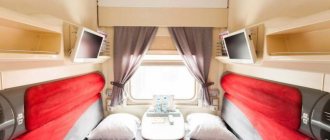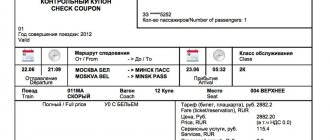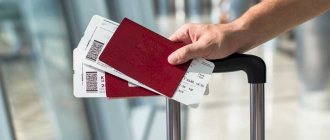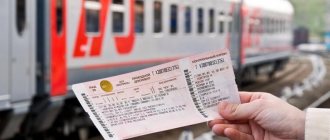Most of us have to use trains from time to time. It is clear that an airplane is a much faster way to get to your destination. But not all settlements can be reached by air, and the cost of a plane ticket will be much higher. Therefore, travelers prefer trains.
The carriages may look exactly the same on the outside, but on the inside?
The most popular types of train carriages are compartment and reserved seat. The difference between them is quite significant. Moreover, the largest percentage of differences is due to the subjective feelings of each individual person rather than to objective reasons. So, what is the difference between a reserved seat car and a coupe?
Coupe or reserved seat - which is better?
Before purchasing a train ticket, you should decide a very important question: are you going to travel in a reserved seat or a compartment carriage. A coupe is considered a more convenient option, while a reserved seat is cheaper, which can be an important factor if you are on a limited budget. The following factors may influence your choice:
- The length of the shelves in the reserved seat is 184 centimeters, and in the reserved seat - 177. For those who are taller than average, this factor can be quite important;
- If you are traveling with a child, it is advisable to choose a coupe. It can be difficult for kids to fall asleep if strangers are constantly walking by. Of course, in a reserved seat you can create the illusion of privacy by hanging a sheet on the top bunk. However, a compartment will create a more comfortable atmosphere when traveling with a child.
- If you decide to travel in a reserved seat carriage, pay attention to branded trains. They are usually more modern and comfortable, and the level of service in them is better than in conventional reserved seats.
- Many people believe that traveling in a compartment can be more dangerous than traveling in a reserved seat carriage - you cannot choose your compartment neighbors if you are traveling alone. But they may not turn out to be very pleasant people, and who knows what might happen when the compartment door closes and you are left completely alone among several strangers. This is especially true for girls traveling unaccompanied. On many trains you can choose a female compartment: this will make the trip safer.
- There are always fewer people in a compartment car, which means you won’t have to deal with such a problem as a queue for the toilet. In addition, there is a mirror on the door, so you can easily clean yourself up before leaving the carriage.
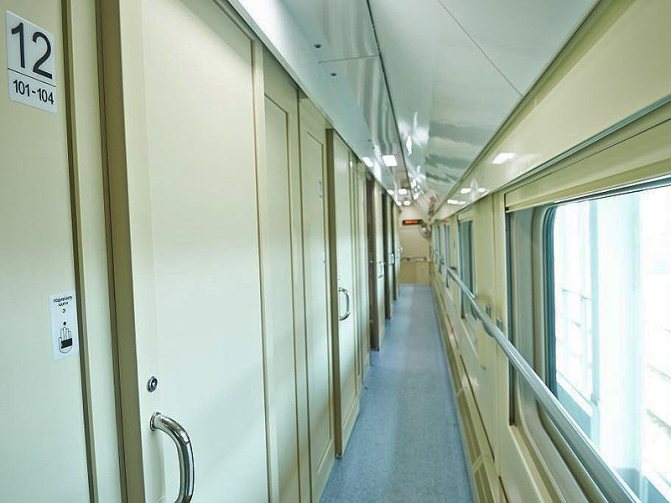
- Do you prefer comfort and are willing to spend a considerable amount of money on your convenience? Then you should choose a sleeping car (SV). There are only two shelves; the compartment may have a TV, which will allow you to pass the time on the road. In addition, most of these carriages are equipped with air conditioning, and each passenger is provided with a set of personal hygiene products and two meals a day - breakfast and dinner.
The difference in cost between a reserved seat and a coupe is on average 10-25%.
The difference between the coupe and SV is approximately 50-60%.
Types and categories of Russian Railways passenger cars with explanation: what is included?
Trains are equipped with wagons depending on the duration of the journey. Suburban trains have only seats. And long-distance trains can have reserved seats, compartments, and first-class seats at the same time. The class of railway tickets varies within the same type of carriage.
Russian Railways has the following types:
- Kupeyny - K. There are 4 sleeping places in one compartment.
- Reservation seat - P. A sleeping car differs from a compartment in the absence of doors.
- Sedentary - S. The carriage has comfortable seating.
- General sedentary – O. A carriage with open seats.
- SV – L . Coupe for 2 people.
- Luxury (RIC) – M. 2-seater compartment with separate bathroom.
Each type has subclasses that directly depend on the type of train.
Passengers do not always have a choice between several classes. Some trains are equipped with only one class, others provide different conditions and services.
Coupe - 2E, 2T, 2B, 2K, 2U, 2F, 2X, 2C, 2N, 2L, 2D
According to Russian Railways statistics, the largest number of tickets are purchased by passengers in compartments. The popularity of compartment trains is understandable. These places are a good combination of value and comfort. The passenger travels in a separate block for 4 people, which makes his journey more convenient and enjoyable.
The compartment carriage can accommodate 32-36 people. The numbering of seats is done in such a way that all odd numbers are at the bottom and even numbers are at the top. The insulated compartment has:
- Door with a lock that can be closed from the inside.
- Large mirror.
- Places to place suitcases.
- Hangers for outerwear.
- Individual night lights.
Compartment cars are single-decker and double-decker.
The difference is the presence of a third luggage rack. It only has two-story compartments. There are 11 classes in compartment cars. They all differ from each other in terms of comfort and the availability of free services. What do 2E, 2T, 2U and other categories in a compartment mean:
- 2F is equipped with air conditioning and a dry closet. The ticket price includes food, drinks, newspapers and bed linen. In double-decker carriages, the traveler's kit (food and drinks) and newspapers are not included in the price.
- 2T is identical in range of services to 2E.
- 2B is always air conditioned, but does not always have a dry closet. Passengers receive a standard package of food, drinks, newspapers and bed linen free of charge.
- 2K – air conditioning and dry closet. Free bed linen.
- 2U is similar to 2K, but there is not always a dry closet.
- 2F, 2X and 2C provide passengers with fresh air and a dry closet. Single-story compartments provide free food, drinks, and newspapers. This is not the case in the two-story building. But a set of linen is given to everyone, regardless of the number of floors in the compartment.
- 2N, 2L and 2D (going abroad) may or may not have air conditioning and a dry closet. Travelers are provided with free underwear.
In classes 2T, 2X and 2D it is prohibited to transport animals, in the rest it is allowed.
Now you know what is included in compartment cars 2E, 2T, 2U and others.
Reserved seat - 3E, 3B, 3T, 3D, 3U, 3L, 3P
A reserved seat carriage is the cheapest option for sleeping accommodations. There are no doors separating the blocks, resulting in more space. There are 9 blocks in the reserved seat, each of which includes 2 lower, 2 upper and 2 side places. Standard “fours” are combined with “side buildings” by a common corridor. The lower shelves are odd numbered, and the upper shelves are even numbered.
The numbering is distributed as follows:
- From 1st to 36th place - “compartment fours”.
- From 37 to 54 - “sides”.
The last block - 33-38 seats, is located near the toilet, which creates additional discomfort.
A reserved seat always has a third luggage rack, which is convenient for placing suitcases, but uncomfortable for passengers in upper berths. Reservation tickets do not include free services, as this is an economy class level. Russian Railways carriages vary in comfort depending on the class and here are their designations:
- 3E and 3B in the reserved seat carriage have air conditioning and a dry closet.
- 3T and 3D in a reserved seat carriage are always with air conditioning, but not always with a dry closet.
- 3U and 3L may or may not have air conditioning and a dry closet.
- 3P are designed for transporting children in groups. They are always equipped with air conditioning and a dry closet.
Air conditioning only works in summer. In classes 3B, 3D and 3U you can bring animals.
With seats - 1R, 1Zh, 2R, 2C, 2Zh, 2B, 2E, 3Zh, 3C
Seat carriages are divided into first, second and third classes . In first class, the seats are arranged in three rows. Each chair can be reclined to a reclining level, which allows you to relax comfortably on the go. The maximum number of seats is 48. The carriage has air conditioning, a dry closet, and often a TV.
- First class tickets may be marked 1P and 1J. In this case, 1P can be one-story or two-story. Standard 1P provides free cold snacks and drinks, as well as blankets if necessary. The two-story 1R and 1Zh, in addition to the above, also provides free press. Transportation of animals is possible only in 1Zh (this is what this category “F” means in a Russian Railways carriage).
- Second and third class are less comfortable. Such carriages have more seats - up to 68, which means less free space. The seats are arranged in four rows; the back of the seats often has folding plastic tables, which allows you to place food and drinks. Cars of this type may not have air conditioning equipment.
Within the second and third classes, services are divided into the following blocks:
- 2P – the traveler’s kit is included in the ticket. The carriage has air conditioning equipment and a dry closet.
- 2C and 2Zh - there is an air conditioner and a dry closet.
- 2B and 2E are equipped with an air conditioning system, but are not always equipped with a dry closet.
- 3Zh and 3C may not have either an air conditioning system or special biological toilets.
In seated carriages of classes 2Zh, 2B and 3Zh you can transport cats, dogs and other domestic animals.
With seats (electric trains) - 1С, 2С, 2Ж, 2В, 2М, 3Ж, 3С
Electric trains differ from standard commuter trains in that they use power lines rather than diesel fuel for transportation. Otherwise, it is the same seating carriage with first, second and third class seats. First class is considered the most comfortable, as it has fewer seats, wider aisles and more space for relaxation.
Electric trains include electric trains and Lastochka trains.
The alphanumeric combination has the following distinctive characteristics:
- In 1C, 2C and 2Zh there is air conditioning and a dry closet is installed.
- In 2B there is always an air conditioning system, but the toilet is not always equipped with a biotank.
- In 2M, 3Zh and 3C, air conditioning and a biotank are not a mandatory attribute, but are sometimes available.
Animals are allowed in 2Zh, 2B and 3Zh.
Luxury (SV) and RIC - 1B, 1E, 1U, 1T, 1L, 1D, 1X, 1F
Luxury and RIC cars are radically different from all of the above. This is a special level of comfort, where compartments have only two seats, and there are simply no overhead bunks. The luxury car, or as it used to be called SV (sleeping car), has from 8 to 10 closed blocks.
There are two types of suites:
- Sleeping shelves with increased softness.
- Sofas with soft backs.
Suites feature not only a reduced number of seats, but also additional benefits. Each compartment has an air conditioning system and a button to call the conductor. The new trains are, among other things, equipped with televisions.
RIC differs from luxury in that it travels abroad, and not within the country. This fact has a positive effect on the level of comfort and is expressed by even more comfortable sleeping sofas and other related services.
Luxury and RIC carriages are divided into the following classes:
- 1B and 1E include food and drinks, newspapers and magazines, and superior bed linen in the ticket price. 1B differs only in that 2 seats are purchased by one passenger.
- In 1U, 1L, 1X, 1F, bed linen is provided free of charge. At the same time, a dry closet is not always provided in 1L.
- 1T provides free travel kits, newspapers and underwear.
- 1D is intended for traveling abroad. Doesn't always have bio tanks in bathrooms. Only linen is provided free of charge, the rest must be purchased separately.
If there are animals, you should choose 1B, 1E, 1U, 1L and 1F.
Soft - 1A, 1I, 1M
A soft carriage is the highest level of travel , comparable to a small hotel room. Traveling in a soft carriage is comfortable in all respects. Coupes can have one or two seats. Moreover, one of them is located on the first tier, and the second on the top. The lower berth looks like a sofa. It can be unfolded to create a bed 1.2 m wide. The top shelf is 90 cm. In addition to this, there is a table, an easy chair, a TV and even a minibar.
Passengers of the soft carriage not only receive a free hot meal, but also have the opportunity to take a shower. Along with the linen set, they receive a disposable wash kit, a large towel and a bathrobe. Soft cars differ solely in the size of individual blocks:
- In 1A there are 4 compartments and a bar where you can buy cold snacks and drinks.
- in 1I .
- There are 6 compartments in 1M
Each compartment has air conditioning, a personal dry closet, washbasin and shower. Pets are allowed.
General - 3O, 3B
The general term is a reserved seat car, which temporarily or permanently serves as a seater. Its main difference is that the upper seats are not used, but the lower seats are used for sitting. Moreover, each berth is intended for three seated passengers. There are also people on the lower side shelves.
In general there are two classes:
- 3О – the seats are indicated on the tickets. Animals are allowed in this class.
- 3B – there are no numbering places, you can take any free place.
Such compounds do not always have air conditioning systems and bio-tanks in the bathrooms.
"Sapsan"
“Sapsan” is a highly comfortable train that, when moving, reaches a maximum speed of 250 km/h. Sapsan has one route from Moscow to St. Petersburg and back. Due to its high speed, it covers the distance between the two capitals in just 4 hours, which is twice as fast as a standard train. All Sapsan carriages are equipped with air conditioning systems, and the toilets are equipped with bio-tank.
The high-speed train offers five ticket prices:
- 1P means that there are 4 seats per compartment. A separate block is equipped with two TVs and a minibar.
- 1B offers increased comfort seating in a common carriage. The position of the leather seats is adjusted using the remote control. Near each seat there is a charging socket and a lamp for comfortable reading and a separate screen for watching entertainment programs or movies.
- 1C – business class. It differs from 1B in that it is equipped with a common video broadcaster for all.
- 2B and 2C belong to the economy level. In both versions, the seat backs are adjustable. 2B has more legroom, and 2C has special stands to prevent your legs from getting tired. There are sockets between the seats only in 2B. Free food is also provided there, which is not included in the 2C service package.
- 2E – bistro car. Seating is arranged in open blocks of 4 around one table. There are 10 blocks in total in the car. When purchasing a ticket for a bistro car, a passenger gets the opportunity to order any dishes from the available menu for free in the amount of 2,000 rubles.
First class (1P, 1B, 1C) provides passengers with free food, newspapers and Wi-Fi. Animals can travel in 1P, 1B, 1C, as well as in 2C, but only in carriages No. 3 and No. 13.
"Swift"
The "Strizh" train is a train moving at high speed. Today it runs in two directions:
- Moscow – Nizhny Novgorod and back.
- Moscow – Berlin and back.
The composition is characterized by increased comfort. It has places of several classes:
- 1P – 1 class with 20 seats. Passengers are provided with a set of food and drinks.
- 2C – 2nd class with 36 seats.
- 1E and 1E – soft berths, distributed 2 pieces in separate compartments. The shelves are located one above the other. In 1E, every traveler is given hot drinks and food for free. In compartment 1E there is a separate toilet, shower, washbasin, as well as sockets and a safe. Meals are provided free of charge twice.
All carriages are equipped with air conditioning systems and dry closets. Pets are allowed to be transported only in 1F and 1E.
Choosing seats in the compartment
When choosing a coupe, you should consider the following nuances:
- The seats located at the beginning and end of the carriage are considered the most uncomfortable. This is not surprising: you will have to ride near the toilet or next to the conductor's cabin (and the second toilet). This means that you won’t be able to rest peacefully - even though the compartment door will separate you from the corridor, you will be able to hear the noise from outside. For this reason, places 1 to 4 and 33 to 36 are usually purchased last.
- If you prefer to ride in the lower racks, buy odd-numbered tickets. True, sometimes tickets for the lower bunks in a compartment are significantly (almost twice) more expensive. However, this may be relevant if an elderly person is traveling and will find it difficult to climb onto the top bunk. Also, the lower shelves are preferable to mothers traveling with a small child.
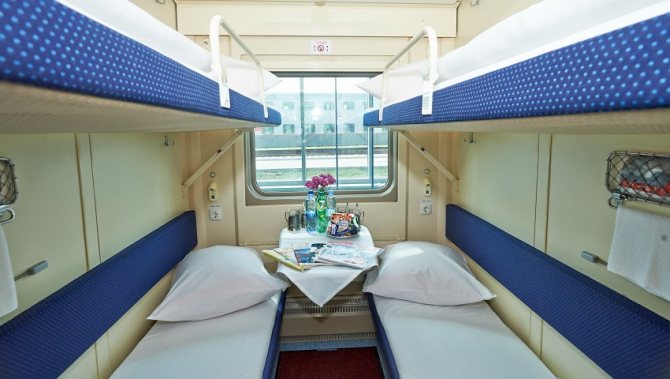
- Do you like fresh air? Then the third and sixth compartments are not for you. It is impossible to open the windows there: they are emergency exits.
- If you like silence, then you should choose seats in the middle of the car - 4-6 compartments (14-23 seats), since people will pass by them less often.

Scheme of a compartment car
Which reserved seat seats are better?
A reserved seat car is less comfortable than a coupe, but many people choose this option because of its low cost. To make your stay in a reserved seat as comfortable as possible, follow these simple tips:
- Do not buy tickets for seats located near the toilet (1-4, 33-38, 53-54). There will be even more anxiety here than in a compartment carriage. In addition, in old carriages there may be a specific smell near the toilets, which is unlikely to make the journey pleasant.
- If you like silence, it is better not to take seats 5-8, 29-32, 39-40 and 51-52, as they are also located near the toilets and people will often walk past them. However, their compartments have separate sockets, so if you often need to charge your phone, watch movies on your laptop, etc., then you might want to consider choosing these places.
- As with the coupe, the bottom seats are odd and the top seats are even, so if given the choice, take the odd bottom seats.
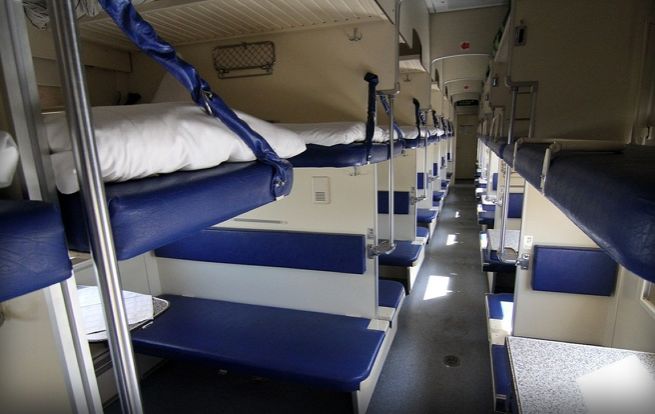
- The most comfortable are the lower bunks in the compartment, and the most inconvenient are the upper side berths. Firstly, they are inconvenient to climb. Secondly, if the person who bought a ticket to the bottom bunk wants to sleep, you will have no choice but to climb onto your bunk or ask your neighbors in the carriage to “shelter” you for a while. It is almost impossible to sit on the upper side bunk of a reserved seat.
- As in compartment cars, compartments 3 and 6 are equipped with an emergency exit, and the windows in them cannot be opened.
- Seats from 37 to 54 are side seats, they are less comfortable than full-fledged compartment seats. However, if you are taciturn and do not really like unnecessary extraneous presence near you, and at the same time you are traveling together, you can choose an upper and lower side seat in one compartment - then you will have a separate table and separate seats from everyone else.
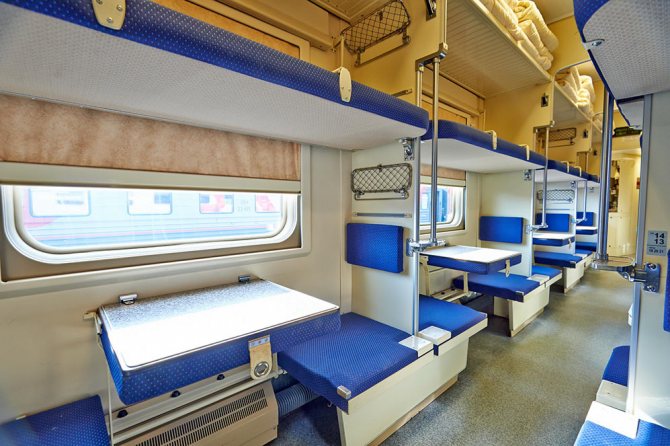
- In old carriages, under the lower compartments there are built-in special drawers for things - the sun lounger is understood, things are folded, and then closed with the same sun lounger. This is the safest way to store things, since to get to them you will need to throw off the person who is lying in his place. However, a person from the top shelf can put his things in the same box, and this can, on the contrary, cause inconvenience - he can at any time ask to open the box to get something, and then the owner of the bottom shelf will have to get up and lift his lounger together with the whole bed. Most modern carriages do not have such boxes.
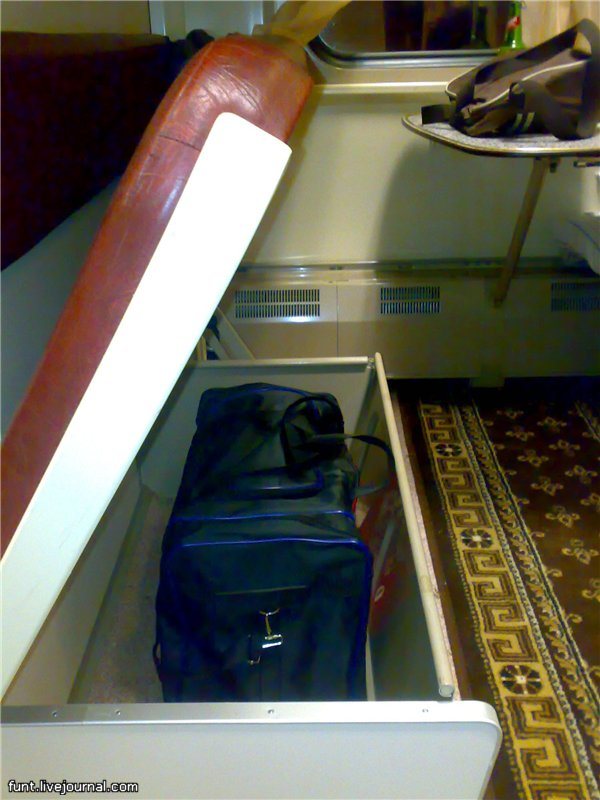
Box in the bottom bunk of the reserved seat - the most inconvenient place is 36 (upper compartment near the toilet). Not only is it shorter than others, but it is also not equipped with special handles for lifting to the top. You can choose such a place only if you are confident in your dexterity.
- seats numbered 1, 2, 35 and 36 are 15 cm shorter than the rest. If you are tall, it will be quite difficult to get comfortable.
- The best places are considered to be the central compartments - 17-20, since the least number of people will walk past them. The most comfortable side seats are 45-46 for the same reason.

Scheme of a reserved seat carriage
What depends on the type of train
The marking of the carriage does not mean that the class of service will be the same on different trains. When purchasing a ticket, be sure to find out if the train is branded.
The above classes of service are guaranteed only on branded trains. Therefore, a ticket for a 2T class compartment on a regular train does not guarantee the entire range of services. It often happens that squads are formed from what they can recruit. Therefore, an old carriage may not have the expected dry closet or air conditioning. And only bed linen will be provided.
What are the best seats in a seated carriage?
Are you planning to travel in a seated carriage? So these tips are for you:
- If you do not like to ride with your back to the direction of travel, before buying a ticket, familiarize yourself with the carriage diagram and, if possible, find out where the carriage numbering begins - from the head or the tail.
- In seated carriages the principle “odd numbered seats by the window” applies. If you like to relax during your trip, admiring the scenery passing by, odd-numbered places are for you. If you want to exercise, tickets for even-numbered seats are suitable.
- Do not forget that seated carriages can hardly be called very comfortable. If you have a long trip ahead, you shouldn’t save money; it’s better to stay in a reserved seat or a coupe. It is convenient to travel in a seated carriage for no more than 8 hours, for example, when traveling from St. Petersburg to Moscow on a Sapsan.
- The best places, as elsewhere, are considered to be the seats in the middle, since the flow of people around them will be minimal.
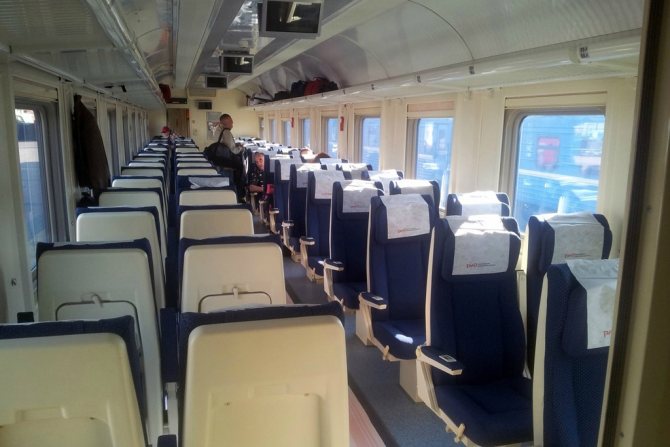
Car with seats
It is also important to take into account the comfort class of the seated carriage; most trains use the following markings:
- 1C. The carriage is quite spacious, equipped with air conditioning, the seat can be set to reclining mode. In addition, in such carriages you are entitled to cold snacks and wet wipes;
- 2C. The carriage has four rows of seats. There may be small tables in the front seats. Most likely, there will be no air conditioning (if its availability is important to you, it is advisable to clarify this in advance when purchasing a ticket);
- 3C. Tickets for such trains are the cheapest, but the trip is unlikely to be enjoyable. There are no air conditioners in the carriages, and the seats are not very comfortable, and sitting in them for several hours on end will be uncomfortable.
There are quite a lot of seated trains, they are varied and equipped with a different number of seats. The fewer seats, the more comfortable the carriage.
- Comfort class ( first class ) trains usually have 43 or 38 seats in three rows, but it all depends on the type of carriage.
There are toilets at the ends of the car, and a TV can be located in the center (optional). If you are traveling alone and do not want unnecessary proximity, then it is worth taking a ticket for a single row. It is difficult to name specific seat numbers, since they are different for different cars, but for the example below, these are 31-43 seats. The comfort in all seats is approximately the same, but it is better to try not to take tickets for the couple of rows closest to the toilets; it is better to ask for something between 5 and 26 or 33 and 41 seats. Scheme of a seated business class carriage on a branded train Moscow - St. Petersburg - Second class trains , called economy, are most often equipped with 54-64 seats arranged in two rows.
It is unlikely that you will be able to travel alone in them. The most comfortable seats will be in the center. Typically, 2C cars have curtains, air conditioning (not always), and folding seats. Scheme of an economy class seating car on a branded train Moscow - St. Petersburg - In the carriages third class there can be a completely different number of seats - from 54 (then the numbering will be like 2nd class) to 90+ - such cars are called general. The number of comfort attributes is minimal - there may not even be curtains, and instead of armchairs there are soft benches. The general carriages have five rows - three on one side, two on the other. In this case, the chairs are installed in pairs opposite each other. For short trips, you can use these options to save money, but it is strongly not recommended to go somewhere far - it will be difficult to even get a little sleep, especially if there will be a lot of people in the carriage.

One of the third class carriage options
Compartment carriages
A coupe is a four-person unit with two beds. The compartment is closed from the rest of the carriage by a sliding door. The shelves do not fold out or fold out.
The table stands alone between two places below. When you lift the bottom bunk, a compartment opens into which you can put your suitcases.
All compartments are equipped with a mirror and a lamp for the convenience of passengers. They do not have a third luggage rack, but there is an additional niche for suitcases under the ceiling. Thanks to this, the person on the upper tier can sit down calmly and nothing will disturb him. There are several classes of coupes.

| Car class | Description |
| 2E | The compartment carriage of service class 2E has:
Also, while traveling, all passengers are given access to an Internet portal with entertainment programs and movies. |
| 2T | A 2T service class carriage is practically no different from a 2E carriage. You just can't carry pets in it. If the carrier is ZAO TKS, then passengers are offered dinner or breakfast (usually their choice), and there are vegetarian dishes on the menu. The 2T TKS compartment has a safe, individual sockets and an LCD monitor. At the passenger's request, they can provide him with a small playpen. For an additional fee you can order good freshly brewed coffee. |
| 2B | There are bed linen, cold snacks, drinks, sanitary and hygiene kit, the latest newspapers, but the presence of a dry closet is not guaranteed. Animals can be transported in these compartments. |
| 2K | In 2K service class carriages, bed linen is provided, there is a dry closet and an air conditioning system. They can transport small animals. |
| 2U | The 2U service class carriage has air conditioning, bed linen and cold snacks are offered to passengers. |
| 2F | The carriage has bed linen, air conditioning, toiletries, but no cold snacks. |
| 2X | The carriage does not allow pets, but it is air conditioned and provides bed linen, newspapers and hygiene kits upon request. |
| 2C | The services of a railway carriage of the 2C service class are completely identical to the services of the 2X type, but here you can transport animals. |
| 2H | The compartment car has a dry toilet, bed linen is provided and small pets can be transported. |
| 2L | Bed linen and cold snacks are provided in the carriage. The 2L service class compartment has air conditioning. |
| 2D (tourist) | Bed linen is provided upon request, but the availability of air conditioning and a dry closet is not guaranteed (depending on the type of carriage in which the indicated compartments are allocated). |

The 2D class compartment is the only compartment car in which you can refuse bed linen. In other carriages, regardless of the travel time, you will have to pay for pillowcases and sheets. Ticket prices for the lower and upper shelves differ by almost 2 times.
Sometimes, as part of a promotion, you can buy tickets for the top berth of a compartment at the price of a reserved seat.
Some trains have only women's and only men's compartments.
When purchasing a ticket, you can choose a seat in such a compartment carriage. The type of compartment determines the gender of the first person who bought a ticket for this compartment. Usually there is an equal number of female and male compartments in the carriage, but much depends on the passengers themselves. If mostly women travel in the carriage, then the compartments will be specifically for women. Tickets are also sold for traditional mixed compartments.
SV-cars
The SV carriage is a compartment with only 2 seats. The shelves are soft beds that do not fold out or fold down. The carriages accommodate 16-20 seats depending on the train composition. All shelves are located at the bottom and have soft backs that are comfortable for sitting.

SV-class coupes are equipped with air conditioning, and a set of linen is provided for each passenger. You cannot refuse bedding. They are automatically included in the ticket price. SV is marked as first class. There are several types of such compartment cars.
| Class | Description |
| 1B | Business class compartment carriage. The ticket is purchased for one adult passenger, who immediately buys the entire compartment. You can bring your pet with you. The ticket price includes:
On TKS carrier trains, compartment 1B also has 2 TVs and a safe. |
| 1E | The level of comfort is no different from carriage 1B, but here you do not need to buy the entire compartment. You can only purchase a ticket for one person. |
| 1U | A comfortable SV carriage, which has all sorts of additional services, but they are not included in the ticket price. |
| 1L | Bed linen is already included in the ticket price. The carriage definitely has air conditioning, but it may not have a dry closet. You can take small animals with you. |

The cost of tickets for the SV carriage is quite high. Trains in CB class compartments will cost more than an airplane flight for the same distance.
Useful tips and life hacks for traveling by train
These recommendations will help make your trip more comfortable, regardless of which places you choose:
- Many modern people prefer to take laptops and tablets on the road. And you also have to charge your phone often. It is important to know that in in the reserved seat carriage there are sockets in the second (5-8 seats) and in the eighth compartment (29-32), and near the side shelves 41 and 49. This is also important to consider if you plan to work on a laptop while on the road. In the compartments there are sockets in the corridor around compartments 3 and 7. If you choose a luxury coupe, you won't have to worry. In such carriages there are usually sockets in each compartment.

- You were unable to purchase a ticket for a seat located near the outlet? a tee with you . Then you can safely charge your gadgets without getting into conflicts with your neighbors. A surge protector equipped with an extension cord will help protect against voltage surges.
- The conductor is obliged to do the laundry himself for elderly people, people with disabilities and pregnant women, without requiring a separate payment for this. You can feel free to ask for this little service if you fall into one of the listed categories.
- Many people know that the ticket can be returned. If you return it no later than 8 hours before departure, a full refund will be given. The closer to departure you are forced to return your ticket, the less money you will get back. You can even return a ticket for a train that has already departed. True, in this case you will only be compensated for the cost of the ticket, but not the price of a seat in a reserved seat. Of course, this amount is relatively small - usually about 30-40% of the total cost.

You can return your ticket even if you missed the train - within 12 hours from the moment of departure - If you arrive at the station in the last minutes before the train departs, you have the right to enter any carriage. True, this rule only applies if you have a ticket purchased at the box office or printed in a special terminal. If you have completed electronic registration, then it is better not to be late for the train: the conductor will only let you into the carriage in which you bought a seat.
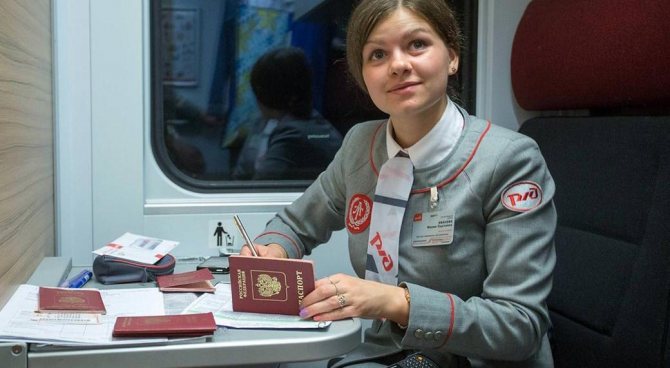
- The passenger is not required to return laundry at the end of the trip. Therefore, you may well refuse to comply with the conductor’s request, which is usually made half an hour before the train arrives at its destination.
- Many people do not know that they have the right to use the toilet in the station building for free if they have a train travel document . According to the rules, you can use the toilet no earlier than two hours before the train departs, but usually only the date stamped on the ticket is taken into account .
- A glass with a cup holder and a spoon in reserved seat carriages are provided free of charge. If the conductor asks you to buy something for tea in exchange for giving out the dishes, you can threaten to report this to the train captain. You can also ask for a sewing kit and a first aid kit free of charge.
What does 2t and 2e mean?
All carriages that Russian Railways provides to passengers can be divided according to several criteria.
- Like.
- To the class.
These criteria show what conditions the passenger will be in and what services he will receive.
According to the first criterion, seated carriages, general carriages, reserved seat carriages, compartment carriages, and SV carriages are distinguished. This is followed by a division into classes, which indicate what services the passenger receives. The class usually has a letter and number designation. Thus, 2t and 2e indicate differences in the second criterion.
Reference! 2t and 2e are a designation of service class.






